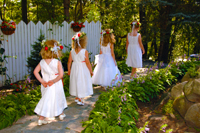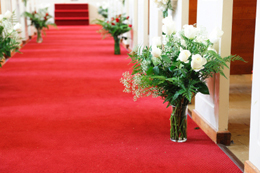Wedding Procession
The wedding procession is steeped in tradition and can be choreographed in a variety of ways. Generally, the wedding procession results in the bride and groom getting married at the altar of a church. The wedding procession includes the entire wedding party. It consists of the bride and groom, sometimes parents and grandparents of the bride or groom, bridesmaids and groomsmen, flower girls and ring-bearers.
Tradition of the Wedding Procession
 Traditionally, the American wedding procession begins with one of the groomsmen walking the mother of the bride to her seat. Then the bridesmaids process down the aisle usually one at a time. The maid of honor is usually the last of the bride’s attendants to walk down the aisle. If there are flower girls in the procession, they generally process right before the bride. Finally, the last in the procession is the bride. Historically, the bride is accompanied by her father who walks her down the aisle to ‘give her away’ to the groom. The groom, groomsmen, wedding officiant and ring bearer are usually awaiting the bride and her party at the altar.
Traditionally, the American wedding procession begins with one of the groomsmen walking the mother of the bride to her seat. Then the bridesmaids process down the aisle usually one at a time. The maid of honor is usually the last of the bride’s attendants to walk down the aisle. If there are flower girls in the procession, they generally process right before the bride. Finally, the last in the procession is the bride. Historically, the bride is accompanied by her father who walks her down the aisle to ‘give her away’ to the groom. The groom, groomsmen, wedding officiant and ring bearer are usually awaiting the bride and her party at the altar.
Cultural Differences
In some European and Asian cultures, during the wedding procession both the bride and groom walk down the aisle together as a couple. In some British cultures the bride leads the wedding procession to the altar so the bridesmaids can hold up the train, a heavy extension of fabric which is part of the wedding gown.
Wedding Procession Materials
 If the wedding takes place in a church, often a long red or white carpet will be laid over the aisle where the wedding procession will occur and this is normally the center aisle of the church. Flowers or a variety of decorations may line the aisle. Often the flower girl of the wedding party carries a basket of flowers or may even drop rose petals on the carpet where the wedding procession takes place. The bride and her attendants usually carry bouquets of flowers down the aisle. When the bride reaches the altar, she may hand her bouquet to her maid of honor so that she can take the grooms hands.
If the wedding takes place in a church, often a long red or white carpet will be laid over the aisle where the wedding procession will occur and this is normally the center aisle of the church. Flowers or a variety of decorations may line the aisle. Often the flower girl of the wedding party carries a basket of flowers or may even drop rose petals on the carpet where the wedding procession takes place. The bride and her attendants usually carry bouquets of flowers down the aisle. When the bride reaches the altar, she may hand her bouquet to her maid of honor so that she can take the grooms hands.
Wedding Procession Music
The wedding procession almost always takes place to some form of music such as the very popular, “Here Comes the Bride‚” wedding procession march. Other popular wedding music that is played during weddings to accompany the bride down the aisle is Pachelbel’s Canon in D Minor, Purcel’s Trumpet Tune and Air, Beethoven’s Ode to Joy and Mozart’s Wedding March from the Marriage of Figaro. Some popular, non-classical wedding procession music includes Louis Armstrong’s What a Wonderful World and Can’t Help Falling in Love by Elvis Presley. If the wedding is held in a church, only hymns or other church-appropriate music may be allowed to be played during the ceremony. Always check with the church officials before choosing music for your wedding procession to make sure it can be accommodated .
Wedding guests may all rise and stand when the bride enters the back of the church.
Wedding Procession Guidelines
The wedding procession may sometimes be timed so the bride can reach the altar at a certain point in the processional music. It may behoove the bride and groom to have a wedding rehearsal so the procession and other key points of the wedding can be practiced prior to the actual event. Having a wedding coordinator at the back of the church or wedding area to queue the attendants so they know when to begin their part of the procession may be helpful. This is especially true if the wedding party is not entirely familiar with the wedding venue.
All eyes are on the wedding party; therefore, always remember to smile and try to relax. Walk slowly! Do not rush up to the altar.
Non-Traditional Wedding Processions
 Some fun ways to liven up a wedding procession would be to mix it up a little, veering away from the traditional procession. If the couple has pets, perhaps they could accompany the bride or bridal party down the aisle. Or if the wedding is on a beach, the bride and groom could come to shore in a boat or canoe. If either (or both) the bride and groom have children, they may accompany their parents down the aisle. Or the groom’s parents could walk the groom to the altar.
Some fun ways to liven up a wedding procession would be to mix it up a little, veering away from the traditional procession. If the couple has pets, perhaps they could accompany the bride or bridal party down the aisle. Or if the wedding is on a beach, the bride and groom could come to shore in a boat or canoe. If either (or both) the bride and groom have children, they may accompany their parents down the aisle. Or the groom’s parents could walk the groom to the altar.
Use the wedding procession, along with the rest of the wedding, to really spotlight both personalities of the bride and the groom. This is their special day after all!




